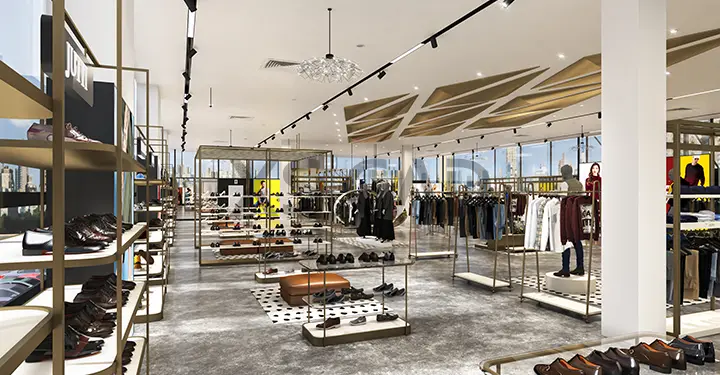Our Articles

Can Store Design Enhance Customer Experience?
In the ever-challenging retail industry, competition is fierce. Facets in addition to stocked shelves and placing the right merchandise in the right location are becoming more important. Shoppers now are looking for an enjoyable experience from the time they enter a retail space to when they depart. Retail store building design is critical to that experience, influencing what attracts customers into a retail space, what keeps them there and what keeps them coming back. Insightful retail space planning, retail space design and accurate retail drawings are critical to the success of customer experiences in a retail space.
The brand and its characteristics need to be communicated in a memorable fashion. This can be helped by investing in:

These features can attract customers, keep them engaged and entice them to make purchases from the time they see the store, enter and finally leave it.
Checking It Out at the Checkout
Store checkouts are the last and final line where the store can make a lasting impression on the customer. For those retailers using advanced point-of-sale technology, such as digital notifications of the day’s best deals or discounts, it is crucial that this technology works flawlessly while supporting the brand image.
Safety in Numbers
People are social by nature and enjoy the company of other people. Retailers typically understand that customer interactions with other customers can influence sales. Thus, intelligent retail space design is important for customers to move about in comfort and safety within the confines of the retail space.
The Magic of Storytelling
Everyone likes a good story or at least a good beginning, an engaging middle and a happy ending. Creating positive and meaningful memories starts on entry to the retail space, how customers are guided to move, what they see, handle and experience and how they feel when they leave. For both new retail spaces and existing ones, retail building design must take this into account.
What’s Shopping without a Little Drama?
Theatrical productions thrive on using lighting, visual aids and the right set design. Retailers can add drama to their spaces with clever lighting, smart visual merchandising and relevant interior design. It has been found that even the sense of smell comes into play when influencing buyers. Sales of women’s wear doubled when those spaces held the aroma of feminine scents. Clever retail space planning can cater to these needs.
An Escape from Reality
For a dose of reality, people can stay home and watch the news. When they enter a shop, they would like to escape to a different world, at least temporarily. Shoppers want a unique experience. Pop-up shops, such as converted old factories, art galleries, cinema halls and even abandoned mills provide opportunities for varied and unique experiences. Dark spaces can be mysterious and intriguing, drawing shoppers in and eager for new experiences, turning away from typical retail space design that advocates bright spaces everywhere.
Curating Skills
Merchandise can be treated as a gallery exhibit for that ‘special’ effect. Some shoe stores display their bright coloured products on a conveyor belt, and bags can decorate a tree-like indoor feature. Retailers with the right curating skills can ensure product relevance and focused shopping, so that buyers can immediately connect to products that most interest them. This experience can be enhanced by using mobile apps to personalise in-store shopping and inform customers on products and deals, all of which need detailed and precise retail drawings from retail design companies.
The Serious Business of Having Fun
Entertainment is an undying human craving. Touchscreens, navigation apps, Instagram walls, interactive digital sales assistants and innovative retail technologies can make amusement parks out of retail spaces. Large digital screens, interesting and relevant sound effects at different zones and live feed of sports matches can all add to the immersive experience, creating happy memories while strengthening the retail brand.
An Almost ‘Sci-fi’ Experience
For retailers, advanced technological aids may soon become basic necessities to enhance customer experiences, such as:
These experiences would necessitate the support of accurate and reliable MEP (M&E) design drawings for shops’ construction design.
How Store Layouts Influence Customers
Cleverly designed store layouts can impact customers in a number of ways, including picking up impulse buys. How does it work? Well, each part of the retail store has a role to play.
To know more about retail space design . . .
Retail space planning and store layouts must be designed with an understanding of the psychology of shoppers. The layout should be inviting and easy to navigate, tempting purchasing behaviour, while offering an ambience that leaves customers with a memorable experience. It’s a tall order. However, with reliable, experienced and expert retail space design support providing accurate and value-added retail drawings, there is a good chance that store design can positively enhance customer experiences.
XS CAD has valuable experience providing retail space planning and retail store building design services for retailers and retail design companies. Our range of services for retailers across the world, include retail building design, retail space design, retail drawings and shops’ construction design services. We have proven to be a preferred retail design services provider, due to the high quality of our retail drawings, retail 3D modelling and retail 3D walk-throughs, created by using Revit, 3Ds Max, V-Ray, Adobe Photoshop and After Effects, Illustrator and BIM Collaboration Pro for cloud collaboration.

